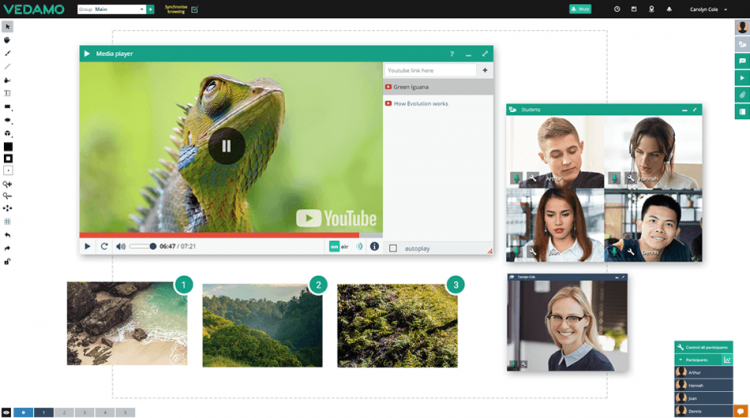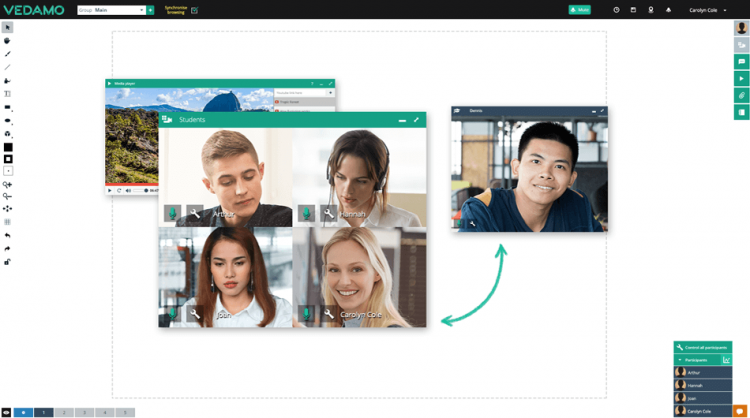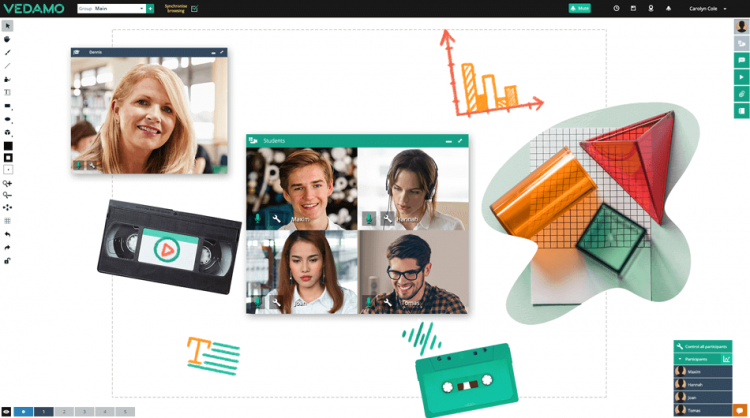The innovations of live teaching platforms lead to new pedagogical approaches. The online tutors have a new role to guide the process of students’ collaborative work and active learning.
Despite the physical separation between tutor and learners within the virtual learning, participants in fact can receive higher personal attention than in a real environment. The virtual environment interaction and learning are boosted by the possibility of using innovative educational strategies, namely:
- Creation of a person-oriented environment based on the various possibilities and tools offered by VEDAMO for learning personalisation (inclusion of various resources corresponding to the different learning styles; easier use of the differentiation approach in education);
- Emphasis upon the constructivist approach in cognitive (learning through active rationalization and exploration) and social (learning through dialogue and cooperation) plan by means of:
- inclusion of cooperative forms of work and collaborative methods and activities for engaging the participants in problem-oriented learning, discussions, reflection and analysis;
- use of simulations, cases, reflective discussions and analysis of the work of the participants as educational tools;
- increasing the active role of the learners in study content development and learning materials design;
- use of educational tools which are directed towards the individual learning style of the learners;

“In the virtual environment the role of the tutor changes significantly where they perform mainly as a moderator and counsellor.”
Synchronous communication in VEDAMO virtual classroom increases the potential for collaboration by providing the possibility for learners to get feedback on their work not only from the tutor but also from their peers. In the virtual environment the role of the tutor changes significantly where they perform mainly as a moderator and counsellor. In VEDAMO Virtual Classroom the tutor can change their role by becoming part of the learners group (using the option Join the Participants Mosaic) and meanwhile they continue to be the group facilitator and expert when learners need their help. Thus the educational interaction turns into a partnership and the virtual environment becomes a flexible space leading to a new educational paradigm – new roles, new educational activities, new tools, etc.
“The online environment and its possibilities change the learner’s role, too: from a passive recipient of knowledge the learner becomes an active seeker, responsible for their own learning.”
The online environment and its possibilities change the learner’s role, too: from a passive recipient of knowledge the learner becomes an active seeker, responsible for their own learning by synthesizing and applying new ideas and concepts, by stimulating their own curiosity and actively being present in the virtual environment. Unlike the traditional educational reality, in the online space the possibilities for information use, quick reference, for developing self-study habits and reflexes are equally accessible for everyone irrespective of their origin, culture, social status, etc.
The learner’s role can also shift from a learner to a teacher when the tutor approved them with presenter’s rights by means of the respective tool in the virtual environment. A learner can be assigned to present a fragment of a lesson, presentation or demonstration, their homework or some other interesting piece of information using part of the teacher’s controls.

Thus, peer-to-peer learning and teaching can take place effectively (i.e. knowledge transference can take place in the characteristic of the learners’ age, way of expression, and in a much more accessible form), whereas the presenter improves their presentation skills and acquires long-term knowledge of the material presented.
In order for the learners to be active participants in the learning process it is recommended that the following educational approaches are applied jointly or severally:
- Addressing individual differences;
- Learners motivation;
- Information overload avoidance;
- Creating a context close to real life situations;
- Promoting social interaction;
- Provision of hands-on activities;
- Promoting reflection on the part of learners;
Taking note of individual learning styles is an important part of learning. The general classification covers seven main learning styles[1]:

- Visual Style – Learners acquire knowledge and skills most easily via pictures, images and spatial perception;
- Audio Style – Learners acquire knowledge and skills most easily via audio recordings and music background;
- Verbal Style (Linguistic) Learners acquire knowledge and skills most easily via texts, irrespective of whether they are written or oral;
- Physical (kinaesthetic) Style – Learners acquire knowledge and skills most easily when they use their body, hands and tactile perceptions;
- Logical (mathematical) Style – Learners acquire knowledge and skills most easily via logic and judgements;
- Social (interpersonal) Style – Learners acquire knowledge and skills most easily in groups and with other people;
- Independent (intrapersonal) Style – Learners acquire knowledge and skills most easily in independent work and self-study.
“Before starting courses in the virtual learning environment it would be a good idea to provide the questionnaire surveys for diagnosing participants’ learning styles.”
Each of the seven learning styles may either be clearly manifested or be combined with another/others in one learner whereas inevitably one of them is prevalent. Learning style recognition may be done by an experienced educational expert by means of purposeful observations, questionnaire surveys or interviews. Before starting courses in the virtual learning environment it would be a good idea to provide the questionnaire surveys for diagnosing participants’ learning styles. Yet, the rule of thumb, for effective learning to take place for participants of different learning styles is providing various study materials (video lectures, audio lectures, text files, graphic representations, etc. cover learning styles from 1 to 4) a varied learning activities balancing group and one-on-one learning (cover the last two styles). The fifth learning style is to be covered in resources and activities envisaged for the other styles whereas logical study content requiring sufficient reflection is incorporated into them.
VEDAMO Virtual Classroom provides a multitude of possibilities for covering the different learning styles whereas for learners who do not show satisfactory progress, it is always easy to provide additional resources and activities to meet their individual needs.
